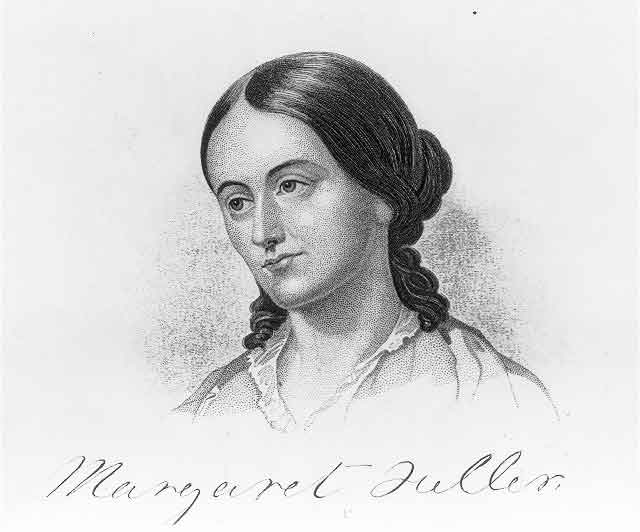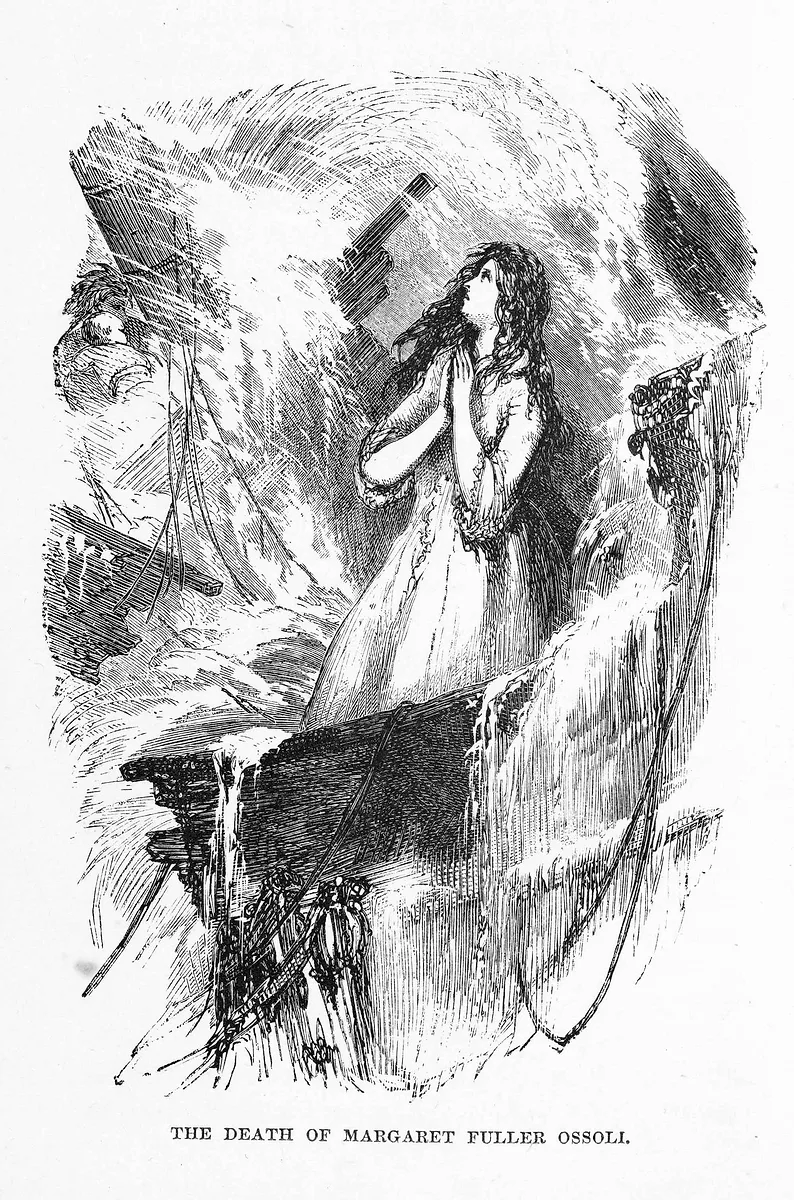It was nearly twelve hours since the Elizabeth ran aground on a sandbar in a raging hurricane. Returning home from Italy in July 1850, after years abroad as a foreign correspondent, Margaret Fuller huddled before the ship’s mast, clutching her two-year-old son, as waves violently washed over the deck. Fuller had given her life preserver to a sailor, who swam to shore for help. Others floated on planks. Terrified by water and unable to swim, Fuller waited for help, as a rescue boat sat on Fire Island beach, approximately three hundred yards away. Scavengers recovered wreckage, plundering washed up trunks and cargo before attempting rescue. Those who made it to shore saved themselves. Desperate, Fuller gave her son to the ship’s steward to swim. A wave swept them into the sea; another swell taking Fuller’s husband and their traveling companion, before the ship broke apart in the swelling tide, and Margaret, too, vanished into the waves.
Two days later, in Boston, Bronson Alcott read the news in the New York Tribune — Margaret Fuller, her husband Giovanni Ossoli, and their son, Nino, were among ten people drowned; nine survived. For Alcott, Fuller’s death created an unfillable void.
Fuller — teacher, editor, and leading voice in the Transcendentalist Club — was a central vortex in Transcendentalist social and intellectual life. Ralph Waldo Emerson lamented he had lost his audience, as if this particular collaborator and friend were the sole recipient of Emerson’s musing, writings, and orations. Indeed, some scholars end date Transcendentalism with Fuller’s death in July 1850, as if she were the movement’s embodied spirit, and its impetus could not continue without her.1

Engraved portrait of Margaret Fuller, with signature.
| Courtesy of the Library of Congress Prints and Photographs Division.Emerson entrusted Henry Thoreau to go to Fire Island. Fuller’s friend William Channing, her brother in-law, Ellery Channing, and her brother Arthur also converged on the wreck-strewn sand, searching for intelligence and hoping to claim the Ossolis’ bodies and property. Emerson sought to recover Fuller’s intellectual remains — her last work, the fabled lost manuscript on the Italian Revolution.
Thoreau’s visit to Fire Island was soul-stirring. He detached from the violently ravaged material remains he discovered, imagining that the spirit withstood the most forceful earthly gale; that Fuller’s truest life continued. A year later though, he was still haunted by the buttons from the coats of drowned men, such as he found from Ossoli’s coat. Thoreau’s Fire Island experiences shaped his imagery and reflections on life and death in Cape Cod (1865).
In his essay “Fate,” Emerson reckoned with Fuller’s tragedy, and her predestined fear that she would never reach shore. He determined to meet limiting circumstances and natural disaster — as when a man or woman is indifferently drown; as if writing directly to Fuller, “your ship swallowed like a grain of dust” — with the individual’s overcoming capacity for willful resistance.2
Fuller’s manuscript was never found. Nor were her or Giovanni’s remains ever claimed.3 There was no funeral service to honor Fuller, but her friends quickly set to work on assembling a literary memoir. Hesitant to criticize the dead and to balance sanctifying reverence, Fuller’s survivors contended with a contested memory, and, ultimately, desires to domesticate her radical reputation.
Fuller’s posthumous image leveraged her as a tamed feminist model. While Fuller continues to primarily be known by her maiden name, her marriage, her motherhood, and her family perishing together at nature’s hands, subdued Fuller’s revolutionary feminism and neutralized her agency had she lived. Nathaniel Hawthorne later privately mused that her human fallibility made her a truer woman than her purported ideal. Two years after Fuller’s death, he published The Blithedale Romance, overtly reflecting Fuller in his heroine “Zenobia,” and “Miriam” in the Marble Faun (1860).
Intellectual interest in Fuller continually returns in tides, ripples, and waves, primarily as a feminist icon. Fuller’s memory empowered feminist reformers into the decades beyond the Civil War. Fuller served as an inspiration to the burgeoning women’s rights movement. She was even resurrected by spiritualist reformers as a spectral voice. Henry James marveled at “the Margaret-ghost” and her persistent afterlife.4 Bronson Alcott devotedly promoted Fuller as the ideal woman, hosting conversations about her until his final illness. In 1901, suffragettes memorialized Fuller with a pavilion overlooking the Fire Island shore where she perished. (The memorial structure and plaque were also lost to the sea in a hurricane).
Margaret Fuller never called Concord ‘home.’ You won’t find her grave in Sleepy Hollow Cemetery. Yet Fuller’s memory is alive in Concord. In 2010, Fuller’s bicentennial was celebrated, and, earlier this year, she was nominated as a namesake for Concord’s new middle school.5 Transcendentalism and Fuller continue to inspire; their ideas carrying on with modern resonances.
NOTES
1 Caroline Dall connected Fuller’s death to Transcendentalism’s demise; “Transcendentalism in New England” (1895), in Myerson, Transcendentalism: a Reader (2000), 675; “Transcendentalism as Feminist Heresy” (1905) in Buell, The American Transcendentalists (2006), 547, 553. Various scholars, notably, Anne Rose (Transcendentalism as a Social Movement, 1981), Phillip Gura (American Transcendentalist, A History, 2007) date Transcendentalism’s end or decline to 1850; Lawrence Buell, explicitly to Fuller’s death, “1850, July 19…” A New Literary History of America, Eds. Marcus & Sollors (2009), 273-277. 2 Emerson, The Conduct of Life (1860). 3 Fuller and Ossoli’s bodies were purportedly never found. Recent scholarship considers evidence that their remains were later found, but not claimed. Albert J..Von Frank, “Margaret Fuller’s Burial at Coney Island,” South Central Review (Fall 2018), 103-112. 4 Phyllis Cole, “The Nineteenth–Century Women’s Rights Movement and the Canonization of Margaret Fuller,” ESQ, (#27, 1998), 1-28. Von Frank, Cole, “Margaret Fuller: How She Haunts,” ESQ (64:1, 2018), 66-131. William Wetmore Story and His Friends (1903), Vol 1, 127. 5 Kelly Walters, “Concord residents weigh in on name for new middle school,” The Concord Bridge, January 25, 2024.


